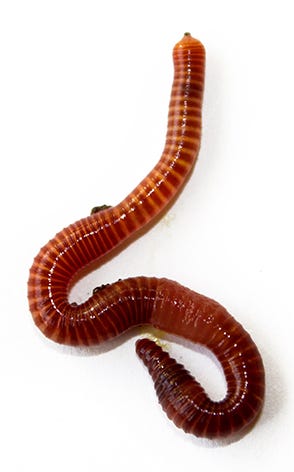Red Wiggler Worms - Necessary for Healthy and Productive Gardens
Red Wiggler Worms - Necessary for Healthy and Productive Gardens
Blog Article
Making Best Use Of the Perks of Red Wiggler Worms: A Comprehensive Handbook for Home Gardeners and Urban Farmers
In the realm of lasting horticulture methods, red wiggler worms stand as unhonored heroes, quietly changing organic waste into nutrient-rich castings that can function marvels for soil wellness. By discovering the intricacies of how to effectively care for and optimize the advantages of red wiggler worms, individuals can unlock a riches of opportunities for improving the sustainability and efficiency of their horticulture endeavors.
Recognizing Red Wiggler Worms
Red Wiggler worms, renowned for their efficient composting capacities, are a types of earthworms commonly utilized in vermiculture methods. These worms, medically understood as Eisenia fetida, flourish in decaying natural material, making them suitable prospects for composting.
One trick feature of Red Wiggler worms is their reproductive rate. These hermaphroditic animals have both women and male reproductive body organs, allowing them to reproduce quickly under desirable problems. A fully grown Red Wiggler can produce several children in a brief period, making sure a constant populace within a composting system.

Establishing a Worm Container
When establishing a worm bin for vermiculture objectives, proper prep work and focus to detail are vital for creating a favorable setting for Red Wiggler worms. Begin by choosing a suitable container for your worm container.

Location the worm bin in a great, dark area far from direct sunshine and extreme temperatures. Routinely keep track of the wetness levels, including water if the bed linen really feels dry or flaky. Feed the worms a well balanced diet plan of vegetables and fruit scraps, avoiding citrus fruits, onions, and spicy foods. By following these steps, you can establish a thriving worm container that will successfully process organic waste right into nutrient-rich vermicompost for your garden.
Feeding and Maintaining Worms
Making certain a balanced and nourishing diet regimen is important for the health and wellness and productivity of Red Wiggler worms in a vermiculture system. It is crucial to avoid feeding them citrus fruits, onions, garlic, dairy items, meat, and oily foods as these can be hazardous to the worms or cause undesirable odors in the container.
Proper dampness levels are additionally essential for the well-being of Red Wiggler worms. By carefully checking their diet, moisture, and ecological problems, home gardeners and metropolitan farmers can sustain a healthy and balanced and productive Red Wiggler worm populace for composting functions.
Gathering Worm Castings
To efficiently remove nutrient-rich worm spreadings from the vermicompost, an organized harvesting process is necessary for making best use of the composting advantages. Red Wiggler Worms. The first action in gathering worm spreadings is to encourage the worms to move to one side of the container. This can be accomplished by positioning fresh food scraps on one side and leaving the opposite side undisturbed for a few days. Once most of worms have actually relocated to the side with fresh food, the castings can be accumulated from the opposite side.
After the spreadings have been harvested, it is important these details to divide any staying worms from the castings to stay clear of damaging them throughout storage or application. One efficient technique is to create conical stacks of castings under intense light. Worms will intuitively relocate far from the light, permitting very easy separation and elimination.
Last but not least, the gathered worm castings should be kept in a cool, dark, and dry location to preserve their quality and effectiveness as a official statement nutrient-rich soil change. By complying with these steps, home gardeners and metropolitan farmers can maximize the benefits of red wiggler worms in their vermicomposting systems.
Using Worm Castings in Gardening
The consolidation of nutrient-rich worm castings right into garden soil can considerably improve plant development and total dirt wellness. Worm castings, also referred to as vermicast, are an all-natural plant food created by red wiggler worms as they break down natural issue. These spreadings are abundant in essential nutrients like nitrogen, phosphorus, potassium, and valuable microbes that promote plant growth and enhance dirt framework.
When making use of worm spreadings in horticulture, it is important to mix them thoroughly into the soil or utilize them as a leading clothing around plants. The slow-release nature of worm spreadings makes certain a consistent supply of nutrients to plants over time, lowering the risk of nutrient leaching and advertising lasting dirt fertility. Additionally, worm spreadings help boost dirt oygenation, water retention, and microbial task, producing a healthy setting for plant roots to flourish.

Conclusion
In conclusion, the application of red wiggler worms in home gardening and metropolitan farming can significantly benefit dirt health and plant development. By comprehending exactly how to set up and preserve a worm container, feed the worms correctly, and gather their nutrient-rich castings, gardeners can make the most of the benefits of these earthworms.
In the realm of sustainable horticulture techniques, red wiggler worms stand as unsung heroes, quietly changing natural waste right you can check here into nutrient-rich spreadings that can work wonders for soil health.When establishing a worm container for vermiculture objectives, correct preparation and attention to information are vital for producing a conducive environment for Red Wiggler worms. The initial action in gathering worm castings is to encourage the worms to move to one side of the container. Worm spreadings, likewise known as vermicast, are a natural fertilizer generated by red wiggler worms as they damage down natural issue. By understanding how to set up and preserve a worm container, feed the worms properly, and gather their nutrient-rich spreadings, gardeners can take full advantage of the advantages of these earthworms.
Report this page